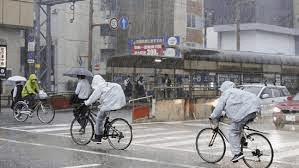Typhoon Mawar: Risk of mudslides and heavy rainfall across Japan’s southern islands
After moving over the Okinawan archipelago and inflicting casualties on a number of people, Tropical Storm Mawar weakened and Friday delivered heavy rainfall to Japan’s major southern islands.
Dozens of local flights were cancelled for the day as residents in at-risk regions were warned of the possibility of floods and mudslides. Strong gusts were still present on Okinawa, where eight individuals suffered injuries. In Nishihara city, a senior citizen who fell suffered a severe head injury; the other wounds were minor.
Mawar, a former super typhoon, travelled east of Okinoerabujima across the Pacific Ocean with gusts reaching 90 kph (56 mph), according to the Japan Meteorological Agency.
Although Okinawa only had minor wind damage, the tropical storm’s warm, wet air was causing seasonal rains to accelerate, raising the risk of floods and mudslides, according to the meteorological office.
Rainfall of up to 35 centimetres (1.1 feet) was anticipated during the next 24 hours till Saturday AM. The organisation warned inhabitants living near rivers and hillsides to exercise care after issuing floods and mudslide warnings in several areas of southern Japan.
After blasting past Guam last week, Mawar mostly avoided Taiwan and the Philippines. Although no significant damage was recorded, it dropped heavy rain to the northern Philippines and drove waves slamming onto Taiwan’s east coast.
In preparation for a North Korean missile launch, Japan had stationed many PAC-3 land-to-air interceptors on southern islands, but owing to safety concerns before the storm, some of them were left on base rather than being placed in their assigned positions. Despite a failed launch on Wednesday, North Korea plans to try again.
The US military was carefully monitoring the storm since it has personnel stationed at a number of locations on Okinawa.
The biggest typhoon to strike Guam in more than 20 years, Mawar pounded the U.S. Pacific island last week. According to the Federal Emergency Management Agency, just 28% of the electricity had been restored as of Wednesday, and only approximately half of the water system was up and running.
Officials predict it will take four to six weeks before electricity is completely restored, and there have been huge lineups for gas. Exactly how many houses were damaged is yet unknown to FEMA.







